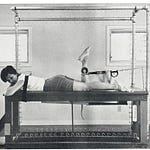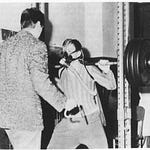History is important. It helps to place contemporary issues in their proper context. It can help us to appreciate the things that we currently have, when those things are better than they were in the past. History can also provide the motivation or yearning for something better, when things in the moment are not as good as they could be. Either way, history informs.
Recently, while searching for information on the history of medicine, I came across a paper, published in 1959, about typhoid vaccination in the United States (U.S.). The article, which was titled “The initial effort to immunize American soldier volunteers with typhoid vaccine,” was written by Colonel W.D. Tigertt and published in the journal Military Medicine. From Tigertt’s historical review, we learn that the first typhoid vaccine in the U.S. was administered in 1904 to a select group of men who were soldiers in the U.S. Army. According to Tigertt, 50 soldiers volunteered for the study. From those 50, 13 were selected by the First Sergeant to receive the vaccine. The ranks and names of the 13 soldiers were:
Tigertt described the case reports for each soldier. From the reports, we learn that the men experienced various undesirable symptoms after receiving the vaccine. Examples included headache, malaise, diarrhea, and increased body temperature. None of the men died from the vaccine.
Reading Tigertt’s article made me think more broadly about individuals who have served as participants in early medical research. More specifically, it made me think about the claim of the exclusion of women as participants in early research.
Holding that thought in mind, I then continued my search. Eventually, I discovered a short, but fascinating piece published in the famous medical journal, JAMA, in 1928. It was an editorial titled, “Martyrs of Medicine.”
In the editorial, the author, describes the history of death from medical experimentation in the early 1900s. The author listed the names of male doctors and researchers who died as a result of acquiring the disease they were studying or who died as a result of the medical technology they were developing. These men and the causes of their deaths included:
Importantly, this list only includes the male doctors and researchers who died from medical experimentation. It does not include the names of men who, like the U.S. soldiers who received the typhoid vaccine, experienced significant undesirable symptoms from medical experiments but eventually recovered. The author of the editorial went on to list such names. They were physicians who had submitted themselves to experimentations associated with inoculation for dengue fever, influenza, measles, and scarlet fever, and their names were: “John Hunter, Hammond, Carroll, Halstead, and Henry Head.”
Men led the way as subjects in early, risky medical experiments. Recognition of this fact is important. It provides additional context for discussions on the topic of “female underrepresentation” in research studies – a topic that I have discussed previously. Putting aside the result that women often are not “underrepresented” as participants in research trials, the notion of the historical “widespread exclusion of women from clinical trials” has been conceptualized as a net negative for women, and a net positive for men. This is because sex discrimination and lack of interest in women’s health issues are assumed to be the causes of fewer female than male participants in research. However, this view does not consider that being a subject in early research might have been something that was not desired. Some research would have been risky. Men have a greater overall proclivity for risk taking than women. Moreover, when different types of risk taking are considered, participation in experiments that might cause physical or psychological harm is a type of risk that shows the largest effect size difference between men and women, with men more likely to participate in such risky experiments. Similarly, my recent survey research revealed that men, on average, are less likely than women to consider factors such as the invasiveness, discomfort, pain, and possible side effects of study procedures when deciding to participate in research. These findings suggest that male ambition and risk taking are factors that require consideration in debates about the historical representations of research participants. Finally, one might also consider that men might have, to some extent, protected women from participating in such research by submitting themselves and their male colleagues to risky procedures first.
One should also not assume that men submitting themselves and their male colleagues to risky experimentation ended in the early 1900s or is restricted to research on infectious diseases. At an academic conference, I was once told a story of well-known male exercise physiologist who used to take muscle biopsies of himself. I was also once told a story of a famous male biomechanist who used to insert sensors into his tendons to better understand their viscoelastic properties. Then, there is Professor Simon Gandevia – one of the supervisors of my PhD thesis. In 1992, Gandevia and two other male researchers in Sydney, Australia gained national media attention when they paralysed themselves as part of an experiment that explored the physiology of breathlessness. The video of this experiment is provided below.
Interestingly, the lack of appreciation for what these men have done for science and society does not appear to be restricted contemporary, feminist-minded researchers. According to the author of the 1928 editorial in JAMA, the value of such men and the importance of their work was generally not well appreciated around the time of their deaths:
“The rolls of medicine contain the names of many practicing physicians and investigators who have died as a result of voluntarily submitting themselves to disease in their search for methods to relieve suffering and to prevent death. The martyrs of medicine whose names remain buried in human neglect might be numbered in the thousands; yet the search for the unknown causes of disease goes on unremittently. Physicians and scientists in chemistry, physics, bacteriology, and toxicology expose themselves again and again to death or to lingering disease, knowing the peril but devoted to the ideals of their professions and to the pursuit of knowledge.”
The author continues:
“The prizes that the world awards for such self sacrifice and martyrdom are not great. The public has not yet learned to appreciate the type of courage that such men display. The investigative spirt that drives them is little understood by the average man.”
History is not perfect. But overcorrecting for any historical flaws with new misguided ideas neither helps to correct the past nor makes for a better future. In fact, many ideas circulating within academia today will themselves be the criticisms of history by future generations. How will people in the future look upon contemporary discussions about men, masculinity, and sex and gender? If the future is bright, it will look upon us and laugh. It will be amazed at the extent to which viruses impacted the health of the human condition. These viruses, however, are not the same types that took the lives of doctors like Allen MacFadyen and Adrian Stokes in the early 1900s. Instead, they are viruses of the mind, and they are extremely potent at breaking down objective and logical thought. Nonetheless, for a future generation to come to this realization, it means that a sequence of preceding steps must have occurred to lead them to their insights about our history. That means that what we do and say from this moment forward is important. It could be the trigger for a correction in future thought. It could be the medicine that kills the virus. And a first dose might include acknowledgment of the martyrs of medicine.
Related Content at The Nuzzo Letter
SUPPORT THE NUZZO LETTER
If you appreciated this content, please consider supporting The Nuzzo Letter with a one-time or recurring donation. Your support is greatly appreciated. To donate, click the DonorBox logo. In two simple steps, you can donate using ApplePay, PayPal, or another service. Thank you.




















Share this post